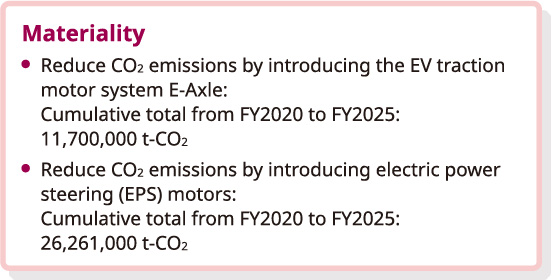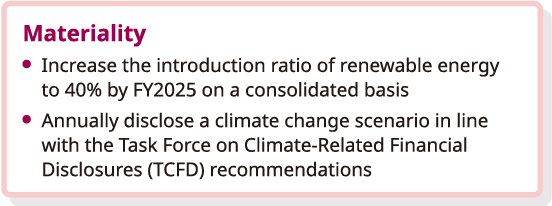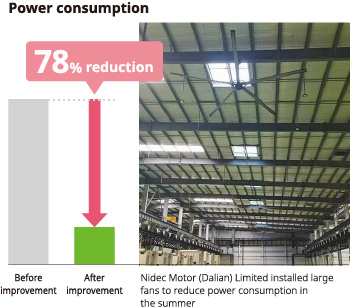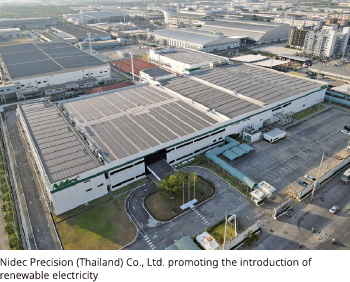Special Feature 2023 - Integrated Report 2023
Environment ― Realize a carbon-free society ―
Contributing to decarbonization through products, Reducing CO₂ emitted in business activities, Manage waste and hazardous waste, Handle water risks
Contributing to decarbonization through products
Basic stance
As global trends toward decarbonization are accelerating in response to intensifying climate change, Nidec, as a global business operator, is committed to the development and supply of products that will contribute to decarbonization. Specifically, focusing on products related to automobiles, which are said to account for over 10% of CO₂ emissions around the world, we calculate and monitor the amount of CO₂ emissions that can be reduced if conventionally used products are replaced with our products.
While our contribution to decarbonization through our products has been recognized to some extent by our investors and other stakeholders, we are aware that visualization of the degree of contribution to a carbon-free society through our products and appropriate information communication are insufficient. Not only the reduction of CO₂ emissions due to the introduction of the E-Axle EV traction motor system and electric power steering (EPS) motors, we will further work to make visible our contribution to decarbonization through many other products, such as motors for small EVs and electric two-wheeled vehicles.

Specific product example➊
Provision of “E-Axle” EV traction motor system
E-Axle is a traction motor system that is the heart of an electric vehicle (EV). It comprises a motor, an inverter, and a reducer and generates rotating torque when installed in a car and connected to its drive shaft. This product alone is enough to run a vehicle. In an extremely harsh competitive environment, speed is the indispensable lifeline for auto manufacturers in EV development. E-Axle, the product that combines an inverter and a reducer, can help auto makers to develop their models more quickly than before.
Specific product example➋
Provision of high-efficiency, energy-saving motors
The key to reducing CO₂ emissions from automobiles is to reduce the load on the engine and improve fuel efficiency. From this perspective, many car manufacturers around the world are increasingly adopting electric power steering (EPS). The Nidec Group supplies EPS motors expected to improve fuel economy by about 5% compared to hydraulic motors.
The Group also offers electric oil pump motors to enable the idling stop function and many other products that will lead to the reduction of emissions of CO₂ and other air pollutants.
For other products, please see below
https://www.nidec.com/en/sustainability/environment/ecofriendly/
Initiatives in FY2022
The total number of units of our EV traction motor system “E-Axle” sold exceeded 700,000 (as of April 2023). A major initiative in FY2022 was the commencement of mass production of the second-generation model of E-Axle, which we had been producing since 2019, in September 2022. Compared to the preceding model, the second-generation model has achieved (1) 19% weight reduction (20% better torque and power density) thanks to the use of smaller magnetic circuits and inverters, (2) significant reduction in the use of heavy rare earth thanks to the adoption of new cooling technology, and (3) reduction in noise. By providing products that are smaller and higher in performance and have less environmental impact, we contribute to the electrification of automobiles and consequently the reduction of CO₂ emissions.
Through the replacement with E-Axle (switching from gasoline vehicles to EVs), a reduction of 253,000 tons* of CO₂ emissions was achieved in FY2022 alone.
* Calculated based on the number of E-Axle units sold in FY2022.
Toward the future
We are proceeding with the development of the third-generation model of E-Axle following the second-generation model, with a view to starting sales in 2024. In addition to achieving further size reduction and higher performance, the new E-Axle will be developed from the preceding “3-in-1” E-Axle model, which comprises a motor, an inverter, and a reducer, into an “X-in-1” unit with other major components added. We will contribute to the accelerating movement toward decarbonization through replacement with the next-generation models with less environmental impact and the expansion of their sales.
Reducing CO₂ emitted in business activities
Basic stance
While contributing to decarbonization through products, NIDEC is also committed to reducing CO₂ emissions in business activities. As the Nidec Group’s energy use is expected to continue to increase due to the expansion of its business scale, including through M&A, we must establish a system whereby CO₂ emissions can be reduced despite an increase in the total amount of energy used. Under these circumstances, our goal for the moment is to achieve a dynamic shift to renewable energy.

Initiatives in FY2022
Starting with a simplified energy efficiency check, we are advancing the initiative to improve the efficiency of air-conditioning systems. Nidec Motor (Dalian) Limited installed large fans, taking advantage of the high ceiling of the press factory to reduce power consumption in the summer.

Regarding the introduction of renewable electricity, we have focused on efforts at each business site. As a result of such efforts, the ratio of renewable energy introduction in FY2022 was 8.2%. Regarding TCFD, we defined the automotive business as the business that is most likely to be substantially affected by climate change and conducted scenario analysis regarding the climate change impact.

Toward the future
We will continue to make these two efforts as a complementary pair: to improve the energy efficiency of our business and to introduce renewable electricity. First, by utilizing a tool to check the company’s energy efficiency and sharing best practices, we will improve the energy efficiency of facilities and equipment at each business site. Next, we will improve the total consolidated introduction ratio of renewable electricity by combining the introduction of renewable electricity at each business site and comprehensive renewable electricity procurement at the regional level. As for the TCFD, we will proceed with the quantitative analysis of climate-related risks and opportunities identified for the automotive products business, and we will also conduct scenario analysis for other business segments.
Manage waste and hazardous waste
Basic stance
As increasing waste has been a global social problem in recent years, Nidec is working to establish a business system to help realize the effective use of raw materials. In addition to eliminating waste as much as possible in the manufacturing process, we are also working to minimize the use of containers and packaging materials. Besides these, we are making continuous efforts to promote recycling by thoroughly sorting waste.
The Nidec Group pays sufficient attention to the use and storage of chemical substances at its business sites to prevent leakage thereof, while striving to reduce the use and emissions of chemical substances as far as possible as part of the initiative to improve and innovate production processes. The Group also utilizes its information systems and analysis techniques to satisfy international regulations concerning hazardous chemical substances contained in products.

Initiatives in FY2022
The amount of waste and valuable resources generated in FY2022 was 135,580 tons. As one way to reduce this amount by 3% per unit of sales by FY2025, we started to identify the amount of waste generated by resource classification based on the main procurement materials for products. With this method, it is possible to estimate the material yield by comparing with procurement data.
Regarding chemical substance management, in accordance with the PRTR system* based on Japanese laws, the Nidec Group keeps track of and discloses information on the amounts of released and transferred chemical substances that are designated by the system and used by the Nidec Group’s sites in Japan.
* Pollutant Release and Transfer Register
Toward the future
We will save resources by reviewing development and design on the product side as an initiative to reduce the amount of waste generated in the future. Furthermore, it is important to improve the material yield in the production process, so we will work to solve the problem by analyzing the generation of waste by resource and visualizing the loss.
Handle water risks
Basic stance
Water is the most important resource and is indispensable for people’s lives and industries. It is said that excluding seawater, icebergs and glaciers, only around 1% of water resources on the Earth are actually utilizable. Nidec recognizes that the risk of water resource depletion has a significant impact on business continuity, such as shortening or suspending plant operations. So we implement water reuse and recycling initiatives to conserve water resources. We are also working on water risk management, such as identifying the risks associated with water withdrawals and discharge to continue our business activities and assessing the impact of water withdrawals and discharge on surrounding areas and water source areas.

Initiatives in FY2022
We evaluated the magnitude of water risk in all global regions where our manufacturing sites are located in order to understand and reduce the impact of water on business activities. In the evaluation, we used the Aqueduct from the World Resources Institute (WRI) and the Water Risk Filter from the World Wide Fund for Nature (WWF), which can evaluate not only physical risks such as water shortages but also water-related regulations and local reputational risks.
Toward the future
We will collect local information, such as local weather, external general conditions regarding water, and government administration, from manufacturing sites in areas where water risk may be high in the future. We will analyze the impact on business activities in detail by referencing this local information and detailed business site information, such as water consumption. We will consider risk mitigation measures while steadily proceeding with the water risk assessment process.

